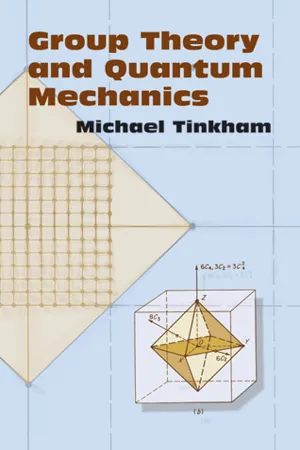![]()
FULL ROTATION GROUP
AND ANGULAR
MOMENTUM
5–1Rotational Transformation Properties and Angular Momentum
Before developing the representations of the full three-dimensional rotation group, let us review the underlying relation between the rotational transformation properties of a wavefunction and its angular momentum.
The linear momentum p of a system may be defined most basically as that quantity whose conservation is a consequence of the translational isotropy of space. Now, the isotropy of space means that the spatial gradient of the Hamiltonian H is zero and hence that ∇ commutes with H. But commutation of an operator with H is the requirement for conservation of that operator in quantum mechanics. Hence we associate ∇ with p and are led to the usual Schrödinger operator replacement p = (h/i)∇.
Considering for simplicity only the x component, we have
where Pδx is the transformation operator which shifts the contours of ψ(x) by δx with respect to fixed axes (or shifts the axes by −δx if the function is considered to be stationary). An alternative way of writing this equation is
where δx is treated as infinitesimal. These equations state the relationship between the linear-momentum operator and the transformation operator Pδx for translational displacement.
In a similar manner, we may define the x component of the angular momentum as the operator whose conservation follows from the invariance of the Hamiltonian under rotations about the x axis, i.e., from ∂H/∂θx = 0. In complete analogy to the linear momentum, we then obtain a definition of angular momentum in terms of infinitesimal rotations,
or
where Pδθx is the transformation operator which rotates the contours of the function by δθx about the x axis in the sense which makes a right-hand-screw advance along x. From this definition we can readily find the transformation operator Pθx for a finite rotation as follows: Let θx = n(δθx), and let n → ∞ while (δθx) → 0 in such a way as to hold θx constant. Then we can write Pθx as the result of n = θx/δθx iterations of Pδθx,
or
where we have used the definition of the exponential ey as the limit of (1 + x)y/x as x → 0. The second form (5–3b) indicates how one could go about calculation with an exponential operator by Taylor’s-series expansion. Clearly a result analogous to (5–3) is true for rotations about any axis, since we have made no special assumptions about the x axis. We have already made use of this result for the z component of the angular momentum in Sec. 4–4 while working out the character of the representations based on the spherical harmonics. Since the z axis was chosen for the axis of quantization, Jz had a definite value mh and we simply found
Note that this result follows directly from the relation between Jz and infinitesimal rotations. Hence it is valid whenever Jz is quantized. In particular, it holds also for half-integral j values where the spherical harmonics no longer serve as basis functions. This observation justifies our use of the formula (4–11) for the character χj(α) for half-integral as well as integral values of j. The double-valued characters noted there are consequences of the fact that, for half-integral j values, P2πΨm(j) = −ψm(j), so that a rotation by 2π leaves the wavefunctions changed in phase.
We can use (5–3) to define the t...








